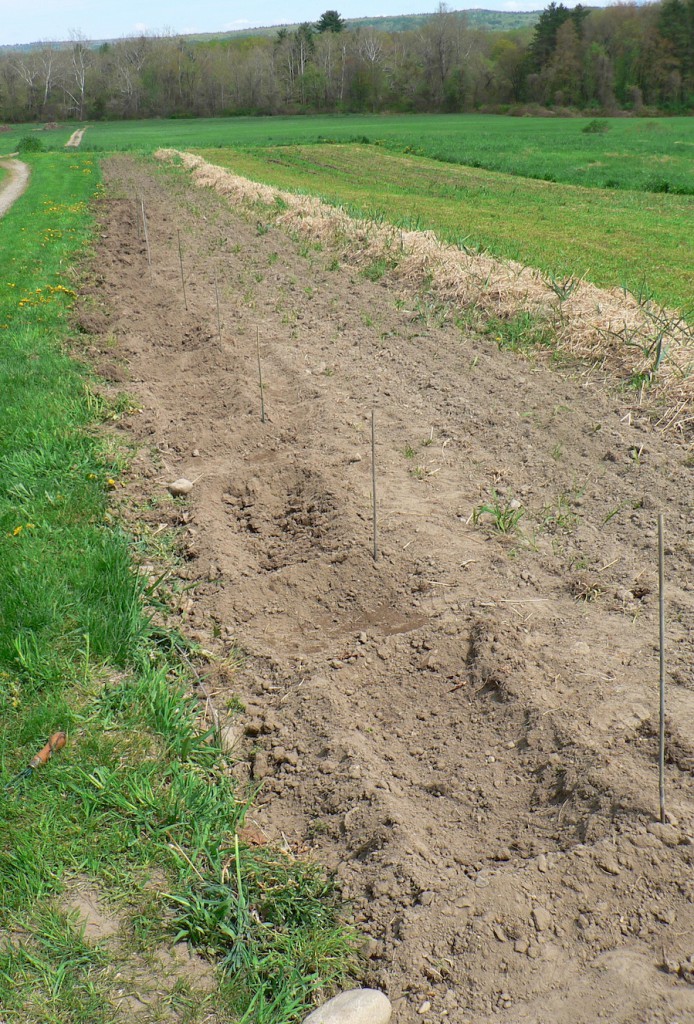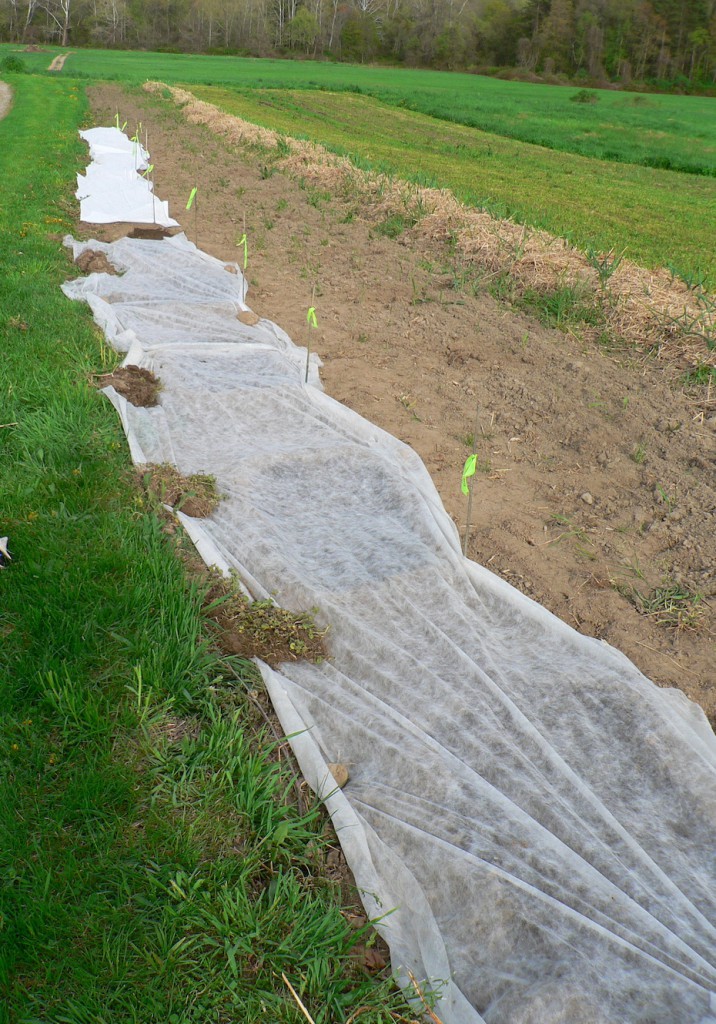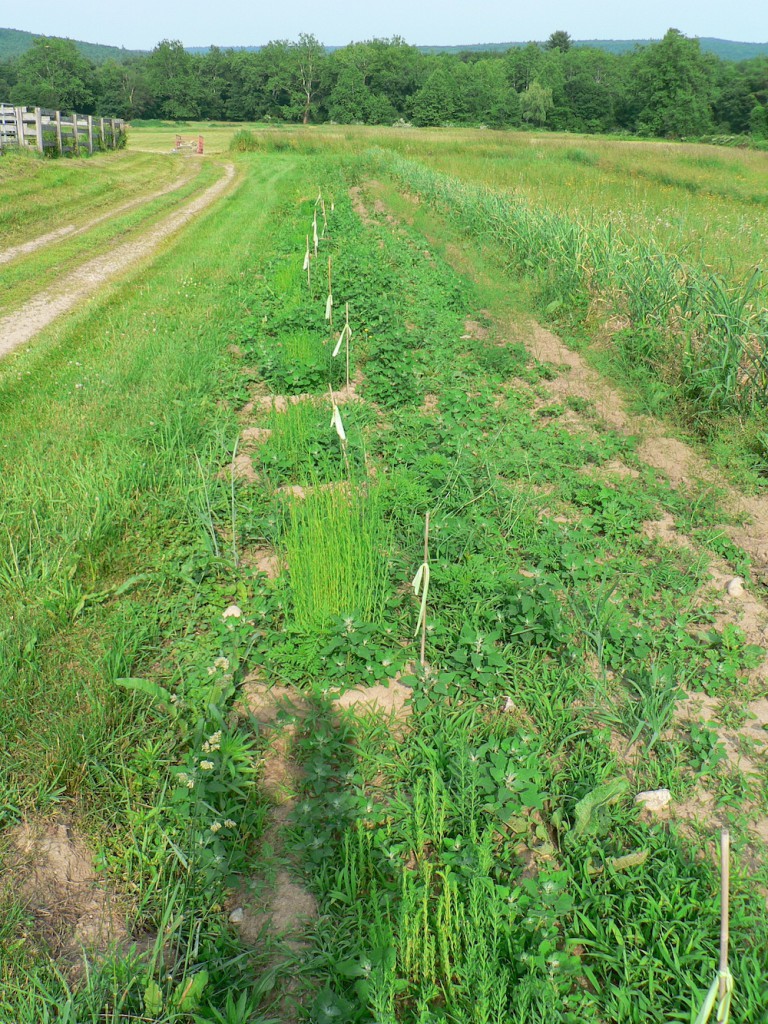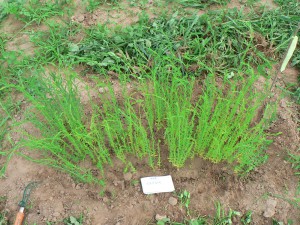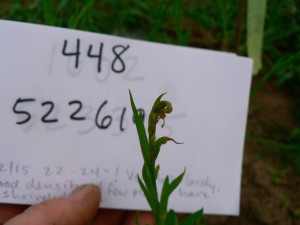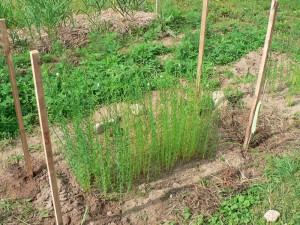Here’s another post about my excellent flax project. Last time I wrote, I posted some images of the little test beds at our community garden plot at Amethyst Brook Conservation Area. This time, I will talk about the beds at Amethyst Farm. The reason both sites have the word “Amethyst” in them is that they are both named after Amethyst Brook, a stream which runs along the valley bottom in our neighborhood. It is a tributary of the Fort River, which in turn is a tributary of the Connecticut River.
Way back on May 9th, I built the beds and planted the second group of flax varieties. Here’s the site. Bernard Brennan of Amethyst Farm was kind enough to plow it all, so I just had to pull up weeds and build the beds. Thanks, Bernard!
You can see that the beds at this site are more rectangular. This is because the strip of land is long and narrow, so longer, narrower beds made sense. Each little bed is the same number of square feet (3 square feet) as at the beds at Amethyst Brook, since I wanted to have a relatively consistent planting density. So, these are one foot by three feet. I planted twelve varieties here. Eleven are from the USDA germplasm system, and one is from seed saver Laura Harris in Washington state. There were 200 seeds in each package from the USDA.
Here are the beds after sowing and watering, tucked under row cover to keep the birds off. The beds at the far end of the photo are covered by a thicker type of row cover, which is why the color is more white and less translucent.
I didn’t buy a thicker type on purpose. When I bought it, I didn’t realize it was any different than the type we’ve bought in the past. The kind we usually buy is very sheer, and we can water right through it. The packaging on this new type specifically stated that you could water through it, but actually I could not. I put it down before I realized this, and then just had to work around it.
We had a very hot, dry spell after I planted, so I watered every day until the seeds germinated. When I watered, I pulled up the thicker row cover, and replaced it when I was done. Despite this inconvenience, there was an unexpected advantage to the thicker row cover: water couldn’t go through it in either direction, so it prevented the water from evaporating as quickly. The beds under the thinner row cover dried out more quickly and the beds under the heavier row cover stayed damp longer. I’m not sure how much of difference this made to the flax seedlings, but it’s something to keep in mind for the future in terms of conserving water.
Skipping ahead a few weeks, here is the site on June 12, sorely in need of weeding. The plants with the silvery leaves are lambsquarters. Yes, I did pick some to eat. Yum.
Here’s a view of one of the beds after I weeded them all. Nice and tidy.
Each of the types from the germplasm system has a six digit acquisition number. Each one also has a shorter name or number to identify it. For the ones that didn’t come with a name (e.g., Lisa, Viking, Ariane, etc.), I’m just using a short number from the package to identify it. So, in my idiosyncratic system, this one is called 448 for short. The white piece of paper in the picture is a little notepad on which I jot down observations as I take photographs of the growth at different stages. 448 had good germination and was a nice height at this point.
At Amethyst Farm, most of the varieties have some kind of wilting on the tips of the plants. In contrast, very few plants at Amethyst Brook were affected. I’m not sure what that is all about. Hopefully I will get more information about it and then I can pass that along. It’s possible that it’s a disease. Flax is subject to a few diseases, and disease resistance is one of the qualities that varieties are selected for. Here’s one of the stems with the wilting affliction:
Skipping ahead even further to the middle of June, the flax is starting to bloom. The earliest variety at Amethyst Brook began flowering on June 14th. Recall, those were planted several days earlier than the ones at Amethyst Farm. The earliest one to flower at Amethyst Farm was 448, which started to bloom on June 19th. It has white flowers.
In this growing season, I am trying to increase the amount of seed I have because 200 seeds is not a lot. It’s only enough for 3 square feet, after all. I want to grow out these same varieties in greater quantity next year, so I want to keep the different varieties from cross pollinating. Issues and questions pertaining to flax pollination are totally fascinating, and will be the subject of my next post.

